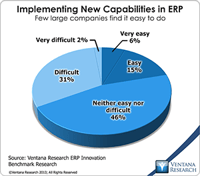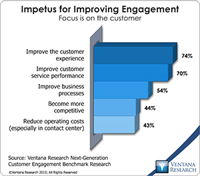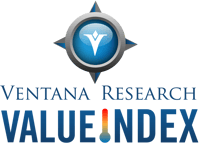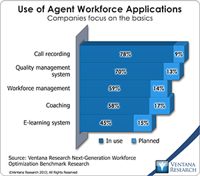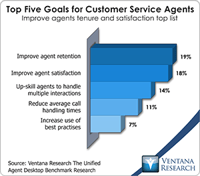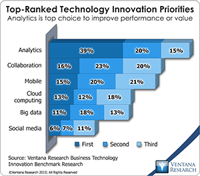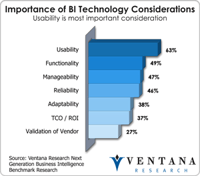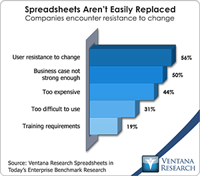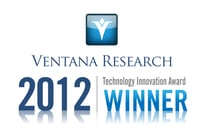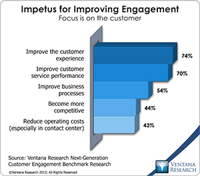In the wake of the past year’s usual crop of failed ERP implementations, I’ve read a couple of blogs that bemoan the fact that ERP systems are not nearly as user-friendly or intuitive as the mobile apps that everyone loves. I’ve complained about this aspect of ERP, and our research confirms that ERP systems are viewed as cumbersome: Just one in five companies (21%) said it is easy to make changes to ERP systems while one-third (33%) said making changes is difficult or very difficult. Yet as...
Read More
Topics:
Mobile,
SAP,
ERP,
Analytics,
Business Collaboration,
Business Performance,
Cloud Computing,
Financial Performance,
Oracle,
CFO,
Infor,
Workday,
Social,
business process,
FPM,
Intacct
In my benchmark research into next-generation customer engagement three-quarters (77%) of participating companies said it is necessary to improve the way they engage with customers. The main drivers for doing that are to improve the customer experience (74%) and improve customer service (70%). However, neither is an easy task because companies now have to support more channels of communication, and more customer interactions are handled by multiple business units within the organization. The...
Read More
Topics:
Big Data,
Social Media,
Customer Analytics,
Customer Experience,
Speech Analytics,
Analytics,
Business Collaboration,
Cloud Computing,
Customer & Contact Center,
Customer Service,
Call Center,
Contact Center,
Contact Center Analytics,
CRM,
Text Analytics
It should be no surprise for those who work in sales that increasing outcomes collectively is not always easy. Sales teams and individuals work under pressure to perform at high levels, selling more than they did in the previous period or more than the person who previously had responsibility for a territory. Today’s economic and competitive environments demand that everyone work not just faster but smarter in their sales efforts. To excel in this environment requires not just wise use of time...
Read More
Topics:
Big Data,
Sales,
Sales Performance,
Social Media,
Operational Performance,
Business Analytics,
Business Collaboration,
Business Performance,
Cloud Computing,
Customer & Contact Center,
Governance, Risk & Compliance (GRC),
Compensation,
Sales Performance Management,
SFA
Envision has carved out a slice of the workforce optimization market by offering its suite of products as cloud-based services. In addition to core products such as interaction recording, quality assurance, workforce management, training, coaching and agent analytics, it offers speech and desktop analytics and customer feedback management through surveys and our part of my research agenda. Our last Value Index shows that this is a highly competitive market, and my benchmark research on ...
Read More
Topics:
Customer Experience,
Customer Feedback Management,
Speech Analytics,
Voice of the Customer,
Operational Performance,
Analytics,
Cloud Computing,
Customer & Contact Center,
Customer Service,
Call Center,
Contact Center,
Contact Center Analytics,
CRM,
Desktop Analytics,
Text Analytics,
Workforce Force Optimization
Paxata, a new data and analytics software provider says it wants to address one of the most pressing challenges facing today’s analyst performing analytics: simplifying data preparation. This trend toward simplification is well aligned with the market’s desire for improving usability, which our benchmark research into Next-Generation Business Intelligence shows is a primary buying consideration in two-thirds (64%) of companies. This trend is driving significant adoption of...
Read More
Topics:
Big Data,
Paxata,
IT Performance,
Analytics,
Business Analytics,
Business Intelligence,
Business Performance,
Customer & Contact Center,
Data Preparation,
Information Applications,
Information Management,
Data Discovery
I am not comfortable with the term “gamification” used in the context of business applications. It sounds as if employees are officially allowed to play games while working and thus take their attention away from the task at hand, which in a contact center is serving customers. So I was skeptical when Uptivity recently wanted to brief me about gamification capabilities it recently announced for its suite of workforce optimization products. I was doubtful that gamification will help companies in...
Read More
Topics:
Social Media,
Customer Analytics,
Customer Experience,
Customer Feedback Management,
Social CRM,
Speech Analytics,
Voice of the Customer,
Mobile Apps,
Self-service,
Operational Performance,
Analytics,
Cloud Computing,
Collaboration,
Customer & Contact Center,
Customer Service,
Call Center,
Contact Center,
Contact Center Analytics,
CRM,
Desktop Analytics,
Text Analytics,
Unified Communications,
Workforce Force Optimization
Businesses are always looking for ways to grow and to streamline their operations. These two goals can come into conflict because as organizations become larger it becomes more complicated to be agile and efficient. To help them understand and modify their processes, businesses can derive insights from analytics applied to their data. Today that data is available not only in the enterprise and cloud computing environments but also from the Internet. To collect, process and analyze it all is a...
Read More
Topics:
Big Data,
Sales Performance,
Social Media,
Supply Chain Performance,
IT Performance,
Operational Performance,
Business Analytics,
Business Collaboration,
Business Intelligence,
Business Performance,
CIO,
Cloud Computing,
Customer & Contact Center,
Financial Performance,
Governance, Risk & Compliance (GRC),
Information Applications,
Information Management,
Location Intelligence,
Operational Intelligence,
Workforce Performance,
Information Optimization
Ventana Research recently released our Value Index on Workforce Management for 2014. We define workforce management as the set of processes by which organizations manage their hourly and salaried employees to maximize productivity. It involves not only tracking time worked and providing compensation for it but also aligning that work to the objectives of the organization and to the individual employee’s needs. Our Value Indexes are informed by more than a decade of analysis of how well...
Read More
Topics:
Sales Performance,
SAP,
Social Media,
Human Capital Management,
Kronos,
Empower,
Operational Performance,
WFM,
Analytics,
Business Analytics,
Business Collaboration,
Business Intelligence,
Business Performance,
Cloud Computing,
Customer & Contact Center,
Mobility,
Oracle,
Workforce Performance,
Ceridian,
Infor,
SumTotal Systems,
Value Index,
Workforce Management,
Workplace
Our benchmark research shows that analytics is the top business technology innovation priority; 39% of organizations rank it first. This is no surprise as new information sources and new technologies in data processing, storage, networking, databases and analytic software are combining to offer capabilities for using information never before possible. For businesses, the analytic priority is heightened by intense competition on several fronts; they need to know as much as possible about...
Read More
Topics:
Big Data,
IT Performance,
Analytics,
Business Analytics,
Business Intelligence,
Business Performance,
Financial Performance,
Information Applications,
Information Management,
Location Intelligence,
Operational Intelligence,
Data
Much has happened for SuccessFactors in the past year as it became more a part of SAP, which acquired it in 2012. One of the most notable changes was the departure of its founder, Lars Delgaard, who set the culture of the company, and the selection of Shawn Price as president. The changes in leadership have come as SuccessFactors shifts away from its position in “business execution” software toward a HR and talent management suite, which aligns it more with what SAP has. (For background, see my...
Read More
Topics:
SAP,
Social Media,
HCM,
Kronos,
Social Collaboration,
SuccessFactors,
Business Analytics,
Business Intelligence,
Business Performance,
Cloud Computing,
Financial Performance,
Workforce Performance,
HR Analytics,
HR Management
Our benchmark research on enterprise spreadsheets explores the pitfalls that await companies that use desktop spreadsheets such as Microsoft Excel in repetitive, collaborative enterprise-wide processes. Because people are so familiar with Excel and therefore are able to quickly transform their finance or business expertise into a workable spreadsheet for modeling, analysis and reporting, desktop spreadsheets became the default choice. Individuals and organizations resist giving up their...
Read More
Topics:
Sales Performance,
GRC,
Office of Finance,
Reporting,
enterprise spreadsheet,
Operational Performance,
Analytics,
Business Analytics,
Business Collaboration,
Business Performance,
Cloud Computing,
Customer & Contact Center,
Financial Performance,
Governance, Risk & Compliance (GRC),
Information Applications,
Information Management,
Workforce Performance,
Risk,
benchmark,
Financial Performance Management
In 2013 we continued to see change in the contact center, customer service and customer experience markets: Consumers’ communication habits continued to evolve, more business units outside the traditional contact center became involved in handling interactions, software vendors continued to come up with new technologies, and cloud computing, mobility, big data, collaboration, social media and analytics all had a big impact on the ways users access and consume software. Many of these trends...
Read More
Topics:
Sales Performance,
Social Media,
Customer Analytics,
Customer Experience,
Customer Feedback Management,
Social CRM,
Speech Analytics,
Voice of the Customer,
Mobile Apps,
Self-service,
Operational Performance,
Analytics,
Business Analytics,
Business Collaboration,
Business Performance,
Cloud Computing,
Collaboration,
Customer & Contact Center,
Customer Service,
Location Intelligence,
Call Center,
Contact Center,
Contact Center Analytics,
CRM,
Desktop Analytics,
Text Analytics,
Unified Communications,
Workforce Force Optimization
Senior finance executives and finance organizations that want to improve their performance must recognize that technology is a key tool for doing high-quality work. To test this premise, imagine how smoothly your company would operate if all of its finance and administrative software and hardware were 25 years old. In almost all cases the company wouldn’t be able to compete at all or would be at a substantial disadvantage. Having the latest technology isn’t always necessary, but even though...
Read More
Topics:
Big Data,
Planning,
Predictive Analytics,
Governance,
GRC,
Office of Finance,
Budgeting,
close,
Tax,
Analytics,
Business Analytics,
Business Collaboration,
Business Performance,
CIO,
Cloud Computing,
Financial Performance,
Governance, Risk & Compliance (GRC),
In-memory,
CFO,
Risk,
CEO,
Financial Performance Management,
FPM
With much fanfare and a rarely seen introduction by CEO Ginni Rometty, IBM launched IBM Watson as a new business unit focused on cognitive computing technology and solutions, now being led by Senior Vice President Mike Rhodin. The announcement is summarized here:. Until now IBM Watson was important but had neither this stature in IBM’s organizational structure nor enough investment to support what the company proclaims is the third phase of computing. As IBM tells it, computing paradigms began...
Read More
Topics:
Big Data,
Sales Performance,
Social Media,
Supply Chain Performance,
IT Performance,
Operational Performance,
Analytics,
Business Analytics,
Business Collaboration,
Business Intelligence,
Business Performance,
CIO,
Cloud Computing,
Customer & Contact Center,
Financial Performance,
Governance, Risk & Compliance (GRC),
Information Applications,
Information Management,
Location Intelligence,
Operational Intelligence,
Workforce Performance,
Cognitive Computing,
Discovery,
Exploration,
IBM Watson
Verint recently announced a definitive agreement to acquire KANA Software. Its goal, in the words of the press release, is to “transform the way organizations engage with their customers.” Customer engagement and customer experience management have become the topics of many conversations in my research area, so I wanted to understand the substance behind this move.
Read More
Topics:
Social Media,
Customer Analytics,
Customer Experience,
Customer Feedback Management,
Social CRM,
Speech Analytics,
Voice of the Customer,
Mobile Apps,
Self-service,
Analytics,
Business Collaboration,
Cloud Computing,
Collaboration,
Customer & Contact Center,
Customer Service,
Call Center,
Contact Center,
Contact Center Analytics,
CRM,
Desktop Analytics,
Text Analytics,
Workforce Force Optimization
Greetings, everyone, and best wishes for a great start to 2014. In this new year, utilizing best practices and skills learned in 2013 will be critical for optimizing the use of efforts to support both business and IT. In 2013 many organizations made progress in balancing technology decisions across business and IT as the lines of business continued to take leading roles in investment and prioritization. Major investments were made in business applications using software as a service, business...
Read More
Topics:
Sales Performance,
Social Media,
Supply Chain Performance,
Market Research,
IT Performance,
Operational Performance,
Analytics,
Business Analytics,
Business Collaboration,
Business Intelligence,
Business Performance,
CIO,
Cloud Computing,
Customer & Contact Center,
Financial Performance,
Governance, Risk & Compliance (GRC),
Information Applications,
Information Management,
Location Intelligence,
Operational Intelligence,
Workforce Performance,
CFO,
COO,
Technology
